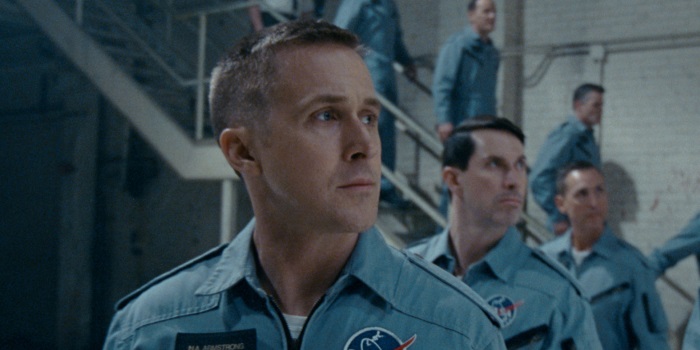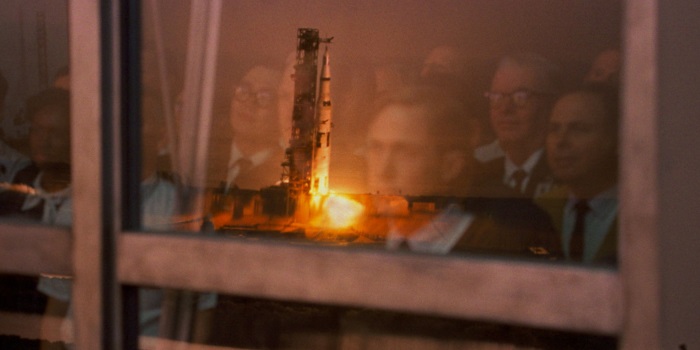
La La Land director Damien Chazelle puts Ryan Gosling on the moon in First Man.
Who is Neil Armstrong?
No, this isn’t a trick question, or me admitting that I’m wildly ill-equipped to review a biopic on one of history’s most famous humans.
People on this planet know he’s the first man to walk on the moon, following NASA’s Apollo 11 spaceflight back in 1969. In fact, if any Earthling were likely to be identified by lifeforms on another planet, Neil would be a contender too. Like, maybe they spotted him during a flyby.
But who is that guy? We probably have a clearer mental picture of his shipmate Buzz Aldrin, thanks to his countless TV cameo appearances in the years that followed (“Second comes right after first!”).
Yet, Neil is an enigma, having steered clear of the limelight up until his death in 2012. And he remains an enigma, even by the end of Damien Chazelle’s biopic First Man. The director reteams with his La La Land star Ryan Gosling, who dons the haircut and helmet for a stoic turn as Armstrong, in a film scripted by Spotlight’s Josh Singer and focused on the decade leading up to Neil’s spacewalk. (Don’t worry: Buzz, played by Corey Stoll, is close behind.) Gosling plays Armstrong as a tightly-coiled professional who is utterly sphinx-like and unreadable, much to the frustration of his wife, Janet (Claire Foy). When he finally gets to the moon (spoilers?), Armstrong’s face is hidden by a reflective helmet that shows only the empty expanse before him. This is as close as we’ll get.
Was First Man intended to solve the mystery of Neil Armstrong? Of what might drive a family man to risk his life going where no man has gone before? Do we even need to know his motivation? Chazelle and Singer settle on an explanation (taking a leap of creative licence), without betraying Armstrong’s reluctance to overexplain his motives. Invented or otherwise, that moment gives the film—with an admittedly predictable ending, because history—an emotional landing.

First Man’s businesslike early sequences drill into the behind-the-scenes experiments and endeavours by NASA’s astronauts and engineers, as they accumulate minor achievements and fatal failures between 1960 and 1969. Neil and Janet’s relationship—as depicted in Singer’s script—is similarly formal, with Gosling and Foy not over-romanticising things or delivering a swooning reunion.
However, the final 30 minutes of First Man are beautiful and balletic, with Chazelle ratcheting up the tension of Apollo 11’s take-off and arrival on the moon, even though, yes, we know how it’ll go down. Justin Hurwitz’s score is somewhat showtuney, and it challenges the current obsession with soundtracks comprised of droning whirs. When married with the right imagery—specifically, that final moon approach—it’s magical.
If you have to compare adventure movies about problem-solving astronauts, Apollo 13 is more fun, and has 100 per cent more Tom Hanks. At least Chazelle fills his cast with supporting stars like Stoll, Jason Clarke, Shea Whigham and Kyle Chandler to guide the often-silent Armstrong to his intergalactic destination. Those parts are gritty and grainy, bringing to mind Chazelle’s urgent Whiplash. At home, cinematographer Linus Sandgren roams freely, and the sequences of Neil playing with his sons, grieving his deceased daughter, and flirting with his wife evoke Terrence Malick’s The Tree of Life (or maybe it was because of all the buzzcuts).
First Man won’t quiet critics who were hoping Chazelle would look beyond his myopic fixation on complicated (white) men on obsessive quests for solitary greatness. Still, it captures a decent and admirable moment in all of mankind’s history with restraint, and, just when you want it, bombast. It also puts the director’s best and worst habits on display. If you get to know anyone better by the end of First Man, it’s Damien Chazelle.
In Australian cinemas 11 October. Rated M for occasional coarse language.
Header Image: Universal Pictures
This article is originally from Student Edge.

